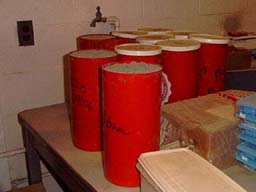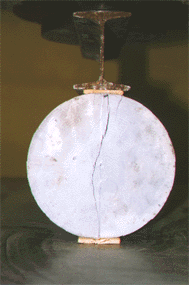|
|
How do we figure out the
properties of concrete?
These are tests that Civil Engineers use to learn about concrete.
|
|
Compressive Strength Test
For this test, concrete is poured into a 6 x 12 in. cylinder (6 in. diameter,
12 in. height). The cylinders are usually plastic, like the ones to the
right. Then each cylinder is loaded in a laboratory:
the cylinder is stood up in a loading machine and an arm of the machine pushes
down on the top of the cylinder until the cylinder breaks. The maximum amount
of force the machine used on the cylinder is important -- the compressive
strength of the concrete.
|
 |
Check out this
movie of a compressive test!

|
|
Split Cylinder Test
This test uses the same type of cylinders as are used in the compressive test
from above. But instead of standing up in the loading machine, the cylinder
lays on its side, as shown to the right. The machine pushes down on the free
side of the cylinder. The cylinder will split in two halves. Based on the
load at which the cylinder split, you can compute a
tensile strength (*), fct, of the concrete. The equation is:
fct=2P/(pi)dL
where P is the load at which the cylinder failed
d is the diameter of the cylinder
and L is the length of the cylinder
|

photo from Cornell University/NSF Project
|
|
The experts (whoever they are) use these properties of concrete to help them
design buildings, bridges, dams, and other things that are made of concrete.
These properties of concrete tell them how much and what kinds of load a
concrete structure can hold. But what about if the concrete is cracked? Well,
that's a whole 'nother ballgame.
Concrete is poor in tension and it cracks whenever it feels too much
tension, or pulling, on it. Concrete cracks quite often. So it is important
to know if that crack is going to grow and cause the whole structure to fail or
if the crack is harmless. So we need to study the crack.
|
What do we need to know about
cracks?


|




